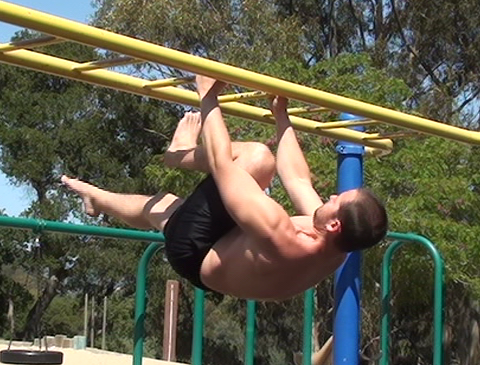This is a guest article from Tyler Bramlett from GarageWarrior.com on the Importance of Movement Progressions.
*****************
It doesn’t matter whether you are a complete beginner or a seasoned athlete there is a good chance that you are already using the little know art of movement progressions. For literally hundreds of year’s gymnasts have use movement progressions to build their elite strength. If you had a chance to watch any of the Olympic trials this year then you probably though to yourself, “how in the hell do people ever get to this level?” right? Well, the simple answer is that they trained smarter and they trained hard using the art of movement progressions.

Tyler doing a Front Lever Progression
So what is a movement progression? A movement progression is any consecutive set of skills that consistently becomes more difficult from an intensity perspective as well as a coordination perspective. Allow me to paint a picture for you of a classic gymnastic movement progression…
…If you walked into a gymnastics studio with the eventual goal of being able to perform the Iron Cross do you think the first move they would start you out on is the Iron Cross? Obviously not. What would most likely happen is your coach (if they were any good) would find the skill level that you were currently at and have you work on mastering that movement. An example would be as follows:
If you were a complete beginner the first thing you would need to master is the bodyweight row and the ring pushup. As simple as this may seem if you can’t do a good bodyweight row or ring pushup then you have no business going to the next level. Next you would ascend to mastering the skill of performing pullups and ring dips. Following that you would learn to master muscle ups and supports, then front and back levers and finally you would then be able to start working on the skill of being able to perform the Iron Cross.
Another example (that is a little more achievable then the iron cross) that I have personally used on myself, my friends and over 100’s of my clients, is a basic squat movement progression. In this progression the most basic version of the squat would be a Ring or TRX assisted Box Squat. This ensures that almost anyone can perform the basic version. From there you lower the height of the box you are squatting to until you reach parallel or below. From there you remove the assistance of using your arms for support and repeat starting with a higher box and ending with a lower box. Once you can squat with just your bodyweight to parallel or below you can start adding weight using a dumbbell or kettlebell in the goblet position held out in front of you. Once you can do a rock bottom squat with 45lbs or more you can move to a barbell front or back squat and from there the sky is the limit on
your bilateral squatting strength. However there is a different rout you can go then just adding more weight to the bar…
…Instead of just focusing on squatting more you can focus on sophisticating the movement. So here’s what this would look like:
Instead of adding weight to your squat, after you are able to do the basic bodyweight squat you move on to a lunge or split squat (a lunge without moving). You keep aiming for a goal number of reps (any rep scheme will do, just make sure to listen to your body) and when you master the basic lunge you put your back foot on a step or a bench. From there you keep progressing the height of your rear foot until you have mastered the rear foot elevated split squat. Now you’re ready to move to the one leg squat.
Just like learning how to do a perfect bodyweight squat, you start with squatting to a box on one leg using your arms for assistance. Once you can go below parallel in this manner, remove the assistance of your hands and just squat on one leg to a box. Slowly lower the height of the box until you are again able to squat below parallel on just one leg. Finally remove the box and you are now the proud owner of a hard earned one leg squat. Where do you go from there?
The sky is the limit, you can choose to add weight to your one leg squat, you can start doing plyometric or jump training on just one leg or you can find dozens of ways to sophisticate the movement even further.
Movement progressions are clearly the way to train if you want longevity, strength and phenomenal coordination!! I get frustrated when I see people focusing on adding an extra 100 reps to their crunch routine. Guess What? Your abs look no better at 1,000 reps then they did at 900! The bottom line is, if you want to be at the cutting edge of your training then you should always know what the next exercise is. This way you can get stronger, save time, build your coordination and master some awesome moves that others will look at in awe! Keep training hard and focus on moving better not just more!!
For much more in step by step movement progressions be sure to check out The Warrior Warmup.

Comments
Thank you very much for this article, Logan! 🙂
… err… or / and Tyler! 🙂
Sure Thing Jean Luc 🙂